Navigation
Small Ecuadorian Clean Water Project Improves Health in Village
Agua Muisne is a non-profit corporation founded in 2007 by a group of Americans and Ecuadorians who are concerned about the many people who are put in grave danger by bad drinking water.
Agua Muisne is a non-profit corporation founded in 2007 by a group of Americans and Ecuadorians who are concerned about the many people who are put in grave danger by bad drinking water.
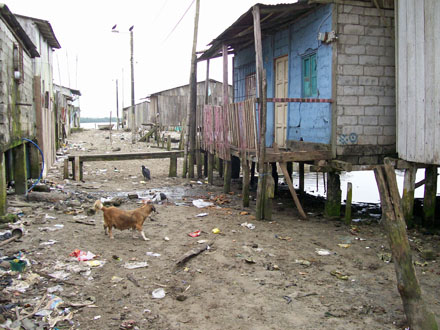 |
| Poor Houses: Much of Muisne is built in a zone that becomes flooded every day at high tide, so the houses are built on stilts. These daily floods create major sanitation problems. |
Our work began in Muisne, a small town on the Pacific coast of Ecuador where many of the wells were full of garbage and had an overpowering stench. Every day, many children came into the local hospital with diarrhea and vomiting.
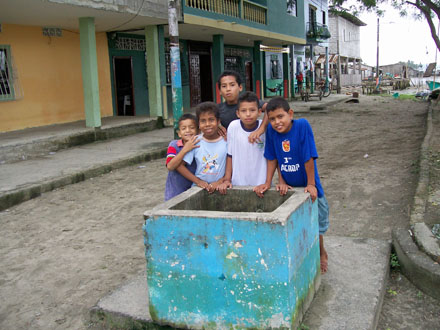 |
| Children play around one of Muisne’s contaminated wells. |
Many people in Muisne thought that their drinking water was the cause of all these illnesses. So in 2007, Agua Muisne tested their drinking water sources for bacteria with the help off a grant from Yale University.
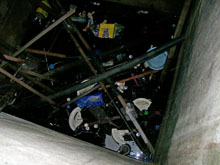 |
| Many of Muisne’s wells are so full of garbage they’re totally unusable. |
The results of the tests were not good. Using an agar medium that detects the presence of e. coli and coliform bacteria, the most dangerous types of bacteria in drinking water, Agua Muisne tested 23 sources of drinking water in Muisne. Every one of the samples was contaminated with bacteria. The water supplied by the government contained over 700 e. coli in 100mL. Some rainwater stored in homes contained over 5000 e. coli in 100mL.
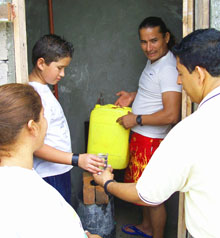 |
| Yili dispensing water for a local family. |
In 2007, Agua Muisne constructed its first water treatment system in Muisne. It uses water from a covered and protected well that is connected to an electric pump. The pump sends the water through two filters and into a concrete cistern where the water is chlorinated to kill all the bacteria. This system uses all the basic mechanisms of an American urban water treatment facility, but on a smaller scale. And when the water produced by this system was tested, no e.coli or other dangerous bacterium was detected in the small samples. This water is tested weekly to verify that it remains free of dangerous bacteria.
This system is the only safe source of drinking water in Muisne and is still providing water to people every day. What’s more, the system is relatively inexpensive because it is low-tech and all the components were purchased locally and built by Agua Muisne volunteers and local craftsmen. The cost of electricity, maintenance and distribution is paid for by the selling cost of the water, which is one cent per liter.
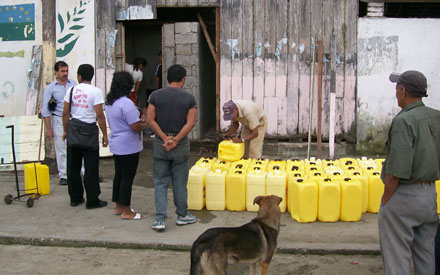 |
| Clean water jugs: People wait to get water for their families. |
In Muisne, the average family used to spend $.66/day for drinking and cooking water because many people bought bottled water from stores; but with this system, they can get the same amount of water for $.25/day.
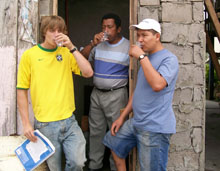 |
| Alex, Fredy, and Hector: People drink the water from the new treatment system with confidence. |
That is the price for 25 liters of water at a cost of one cent per liter.
There are several constraining factors in this project, however. At the moment, many people in Muisne have not permanently adopted this water source. Agua Muisne is currently working on educational programs to inform people in Muisne about the dangers of rainwater when it is collected and stored in dirty, uncovered tanks.
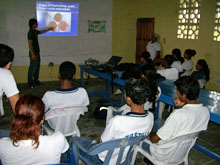 |
| Powerpoint in high school: Alex, an Agua Muisne volunteer, gives a presentation on hygiene and water use in Muisne’s high school. |
We are working with local schools to give presentations on good drinking water practices and have been leading discussions in public areas in Muisne to inform people about the dangers of dirty water and how they can protect themselves by using safe drinking water sources and practicing good hygiene.
Most households still consume rainwater when it is available, and only turn to the water from the treatment system when there is no rainwater. While during a dry period the treatment system may provide safe water to 600 people, during a rainy period the number sometimes drops to 200.
One other sources of difficulty to get the project underway was the role of the municipal government in the project. At first, local officials were skeptical of the work because our research contradicted their claims that the municipal water system provided safe drinking water. However, local officials have recently been supporting the new treatment system because they have seen the benefits it has had on the health of the people of Muisne.
Even when illnesses caused by contaminated drinking water do not kill, they often debilitate people with diarrheal diseases, vomiting, and dehydration. In children these illnesses can affect their development, and in adults these illnesses can prevent them from working and providing for their families.
The doctors in the hospital in Muisne have already noticed a decline in the number of diarrheal illnesses. This water treatment system undoubtedly is making a difference in the lives of many people.
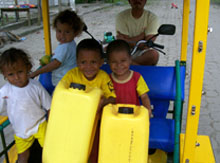 |
| Lennon and his friends are healthier now that they drink water from the new treatment system. |
One child who has been affected by this project is three-year-old Lennon. Before Agua Muisne constructed the treatment system in Muisne, Lennon’s belly was swollen from repeated infections with parasites. Since his family started getting their water from the treatment system, his parents say he has not been getting upset stomachs and has been much healthier.
Agua Muisne Corporation is currently working to expand this project.
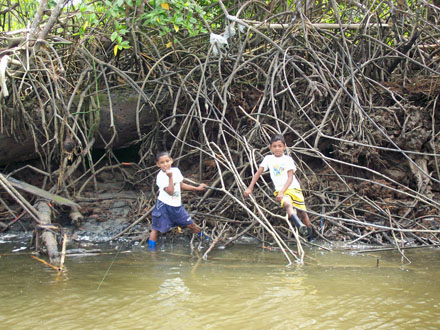 |
| Mangroves near Muisne: Muisne used to derive much of its income from the wildlife in these mangroves, but deforestation has lowered harvests greatly. |
There are many villages all around Muisne that still rely upon wells full of garbage and rainwater stored in dirty, uncovered tanks. Because these villages are more isolated than Muisne, their residents know even less about proper water hygiene.
Even more than Muisne, therefore, these towns need clean sources of drinking water.
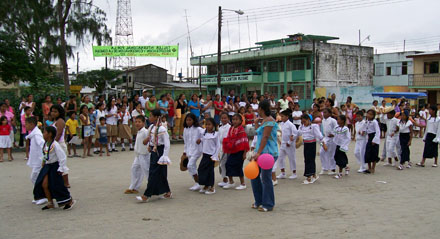 |
| Students have a parade through Muisne to celebrate the founding of their school. |
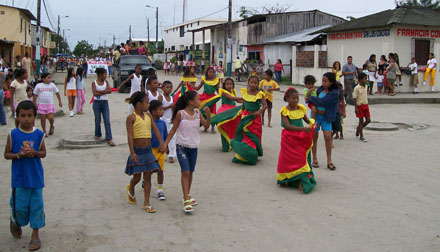 |
| Muisne Parade |
Note: E. coli numbers are represented in colony forming units (CFU) / 100 ml of water. They have not as yet tested for heavy metals or anything else because of lack of equipmen, but report that they hope to do so in the summer of 2008.
Author and Photographer: Alexander Harding, Yale University Student, Class of 2008, and member of the Agua Muisne Corporation Board of Directors. He was in Muisne June-July 2006, June-August 2007 and in June of 2008.
Contact:
Alex Harding
Phone: (1) 443-858-5869
Note:
For more information, see Agua Muisne's website, www.waterecuador.org. Agua Muisne is a 501c(3) corporation, and all donations are tax-deductible. Contributions to Agua Muisne’s efforts to expand this project to the villages around Muisne can be made via www.waterecuador.org, or checks can be made out to Agua Muisne Corporation. Inquiries or checks can be mailed to:
Agua Muisne Corporation
6014 The Terraces
Baltimore, MD 21209
Board of Directors:
Eduardo Rebolledo Monsalve
Eytan Debbi
Alexander Harding
Robert Harding
Tiffany Leigh
Search
Latest articles
Agriculture
- World Water Week: Healthy ecosystems essential to human health: from coronavirus to malnutrition Online session Wednesday 24 August 17:00-18:20
- World Water Week: Healthy ecosystems essential to human health: from coronavirus to malnutrition Online session Wednesday 24 August 17:00-18:20
Air Pollution
- "Water and Sanitation-Related Diseases and the Changing Environment: Challenges, Interventions, and Preventive Measures" Volume 2 Is Now Available
- Global Innovation Exchange Co-Created by Horizon International, USAID, Bill and Melinda Gates Foundation and Others
Biodiversity
- It is time for international mobilization against climate change
- World Water Week: Healthy ecosystems essential to human health: from coronavirus to malnutrition Online session Wednesday 24 August 17:00-18:20
Desertification
- World Water Week: Healthy ecosystems essential to human health: from coronavirus to malnutrition Online session Wednesday 24 August 17:00-18:20
- UN Food Systems Summit Receives Over 1,200 Ideas to Help Meet Sustainable Development Goals
Endangered Species
- Mangrove Action Project Collaborates to Restore and Preserve Mangrove Ecosystems
- Coral Research in Palau offers a “Glimmer of Hope”
Energy
- Global Innovation Exchange Co-Created by Horizon International, USAID, Bill and Melinda Gates Foundation and Others
- Wildlife Preservation in Southeast Nova Scotia
Exhibits
- Global Innovation Exchange Co-Created by Horizon International, USAID, Bill and Melinda Gates Foundation and Others
- Coral Reefs
Forests
- NASA Satellites Reveal Major Shifts in Global Freshwater Updated June 2020
- Global Innovation Exchange Co-Created by Horizon International, USAID, Bill and Melinda Gates Foundation and Others
Global Climate Change
- It is time for international mobilization against climate change
- It is time for international mobilization against climate change
Global Health
- World Water Week: Healthy ecosystems essential to human health: from coronavirus to malnutrition Online session Wednesday 24 August 17:00-18:20
- More than 400 schoolgirls, family and teachers rescued from Afghanistan by small coalition
Industry
- "Water and Sanitation-Related Diseases and the Changing Environment: Challenges, Interventions, and Preventive Measures" Volume 2 Is Now Available
- Global Innovation Exchange Co-Created by Horizon International, USAID, Bill and Melinda Gates Foundation and Others
Natural Disaster Relief
- STOP ATTACKS ON HEALTH CARE IN UKRAINE
- Global Innovation Exchange Co-Created by Horizon International, USAID, Bill and Melinda Gates Foundation and Others
News and Special Reports
- World Water Week: Healthy ecosystems essential to human health: from coronavirus to malnutrition Online session Wednesday 24 August 17:00-18:20
- STOP ATTACKS ON HEALTH CARE IN UKRAINE
Oceans, Coral Reefs
- World Water Week: Healthy ecosystems essential to human health: from coronavirus to malnutrition Online session Wednesday 24 August 17:00-18:20
- Mangrove Action Project Collaborates to Restore and Preserve Mangrove Ecosystems
Pollution
- Zakaria Ouedraogo of Burkina Faso Produces Film “Nzoue Fiyen: Water Not Drinkable”
- "Water and Sanitation-Related Diseases and the Changing Environment: Challenges, Interventions, and Preventive Measures" Volume 2 Is Now Available
Population
- "Water and Sanitation-Related Diseases and the Changing Environment: Challenges, Interventions, and Preventive Measures" Volume 2 Is Now Available
- "Water and Sanitation-Related Diseases and the Changing Environment: Challenges, Interventions, and Preventive Measures" Volume 2 Is Now Available
Public Health
- Honouring the visionary behind India’s sanitation revolution
- Honouring the visionary behind India’s sanitation revolution
Rivers
- World Water Week: Healthy ecosystems essential to human health: from coronavirus to malnutrition Online session Wednesday 24 August 17:00-18:20
- Mangrove Action Project Collaborates to Restore and Preserve Mangrove Ecosystems
Sanitation
- Honouring the visionary behind India’s sanitation revolution
- Honouring the visionary behind India’s sanitation revolution
Toxic Chemicals
- "Water and Sanitation-Related Diseases and the Changing Environment: Challenges, Interventions, and Preventive Measures" Volume 2 Is Now Available
- Actions to Prevent Polluted Drinking Water in the United States
Transportation
- "Water and Sanitation-Related Diseases and the Changing Environment: Challenges, Interventions, and Preventive Measures" Volume 2 Is Now Available
- Urbanization Provides Opportunities for Transition to a Green Economy, Says New Report
Waste Management
- Honouring the visionary behind India’s sanitation revolution
- Honouring the visionary behind India’s sanitation revolution
Water
- Honouring the visionary behind India’s sanitation revolution
- Honouring the visionary behind India’s sanitation revolution
Water and Sanitation
- Honouring the visionary behind India’s sanitation revolution
- Honouring the visionary behind India’s sanitation revolution

